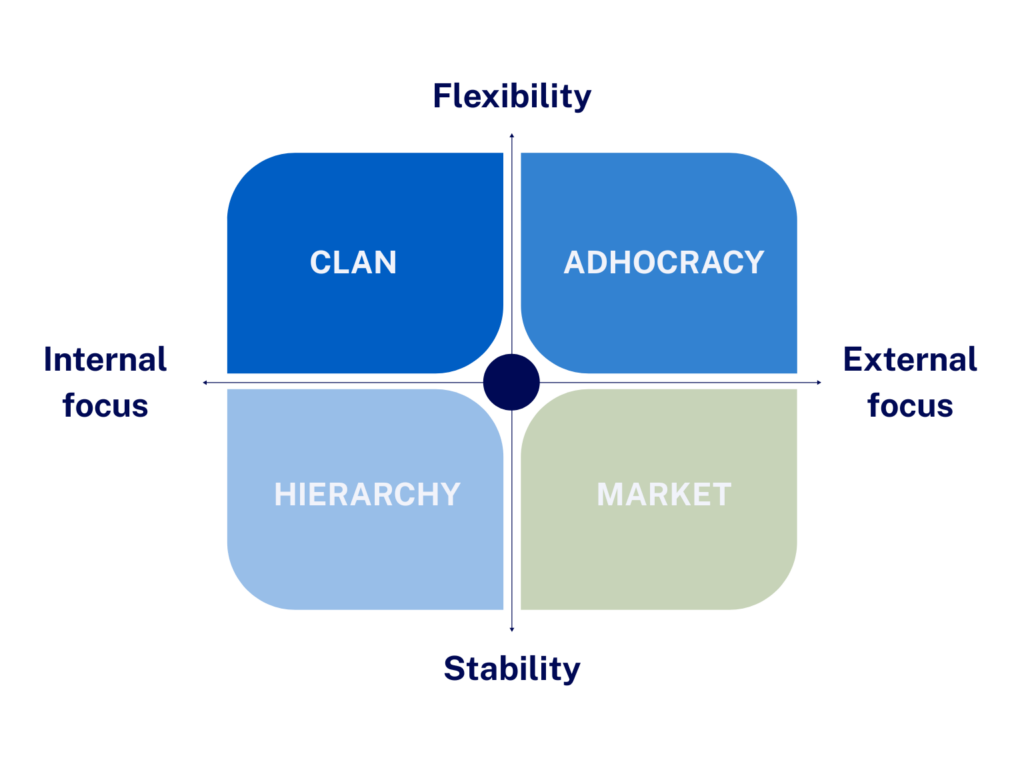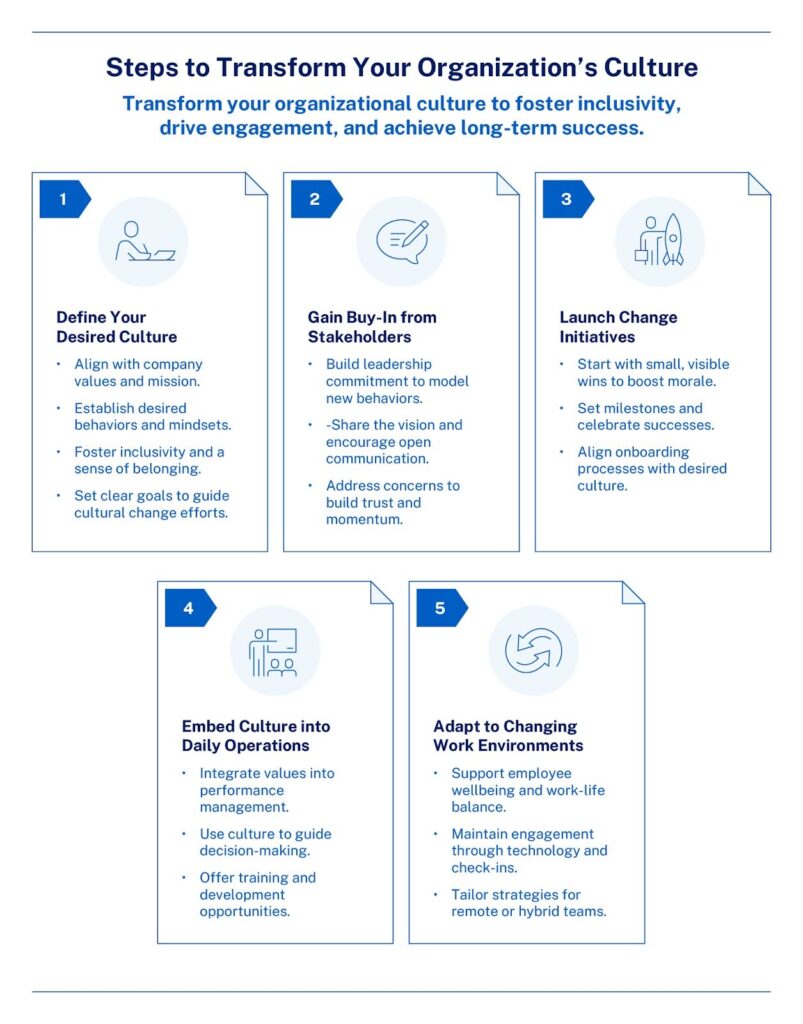The 4 types of organizational culture explained (and how to pick the right one)
Across companies, the workplace experience can feel dramatically different. In one, employees collaborate openly, ideas flow easily, and decisions are made quickly. In another, communication is guarded, hierarchy dominates, and people hesitate to take risks. Neither environment is accidental, they reflect different types of organizational culture that shape how people work and how businesses perform.
But what exactly is organizational culture? Why does it matter for performance and resilience? And what are the four types of organizational culture that leaders should know before deciding which one fits their business best?
This article answers those questions, exploring the definition of organizational culture, its key characteristics, and the different types that influence how organizations operate. We’ll also look at how to assess your current culture, adapt it to changing needs, and build an environment where people and performance thrive together.
Let’s start with the basics…
- What is organizational culture?
- What are the 4 types of organizational culture?
- How to choose the best type of organizational culture for your company?
- Steps to transform your organization’s culture
- Common challenges and how to overcome them
- Achieving long-term success
What is organizational culture?
Organizational culture is the set of shared values, behaviors, and assumptions that guide how people work together and make decisions. It’s not written in a handbook or defined by perks like “free coffee”: it’s the everyday mindset that shapes how employees interact, solve problems, and respond to challenges.
Strong cultures tend to share certain features:
- Clarity of values: People know what the company stands for and how it expects them to act.
- Consistency of behaviors: Daily decisions reflect those values, from leadership choices to frontline actions.
- Sense of belonging: Employees feel part of something bigger, which strengthens retention.
- Adaptability: A healthy culture evolves with the environment, supporting long-term resilience.
Organizational culture matters because it directly influences performance. Companies with aligned cultures consistently report higher employee engagement, stronger collaboration, and greater capacity for innovation. In contrast, a weak or toxic culture often results in disengagement, resistance to change, and high turnover. For leaders, culture is both a risk and an opportunity, it can either accelerate strategy or quietly undermine it.
In short, organizational culture is the invisible system that drives how a company operates every day. To see how it works in practice, it helps to look at the four types of organizational culture most commonly found in business today.
How to assess your current culture?
Before launching a cultural transformation, it’s essential to evaluate your current culture. A thorough culture assessment reveals strengths, weaknesses, and areas for improvement.
- Leverage employee surveys. Use tools like Gallup Q12, Culture Amp, or Workleap to gather insights into how employees perceive the work culture and their day-to-day experiences.
- Conduct focus groups. Facilitate discussions using frameworks like the Appreciative Inquiry model to encourage open communication about challenges and opportunities while emphasizing positive aspects of the culture.
- Engage the leadership team. Use Organizational Culture Assessment Instrument (OCAI) to align leadership perspectives with the desired cultural outcomes and strategic goals.
- Identify gaps. Analyze feedback using tools like SWOT analysis (Strengths, Weaknesses, Opportunities, Threats) or McKinsey’s 7-S Framework to uncover discrepancies between the existing culture and the desired culture.
A clear understanding of where you stand sets the stage for meaningful change initiatives.
What are the 4 types of organizational culture?
According to Robert Quinn and John Rohrbaugh’s Competing Values Framework (CVF), most organizations fall into one of four broad cultural categories. The model maps culture along two dimensions—flexibility versus stability, and internal versus external focus—producing four quadrants: clan, adhocracy, market, and hierarchy. Each represents a distinct way of working and leading, with its own advantages and limitations.

With that context in place, let’s take a closer look at the four types of organizational culture and what they mean for leaders:
1. Clan culture: collaborative and people-focused
Clan culture treats the organization like a family. Leaders act as mentors, teamwork is encouraged, and employees feel a strong sense of belonging. The focus is less on competition and more on building trust and loyalty across the company.
In day-to-day work, this culture is reflected in:
- Open communication across all levels.
- Cross-functional collaboration between teams.
- Collective celebrations of success.
- Leaders who emphasize coaching and development.
The main strength of clan culture is engagement. Employees who feel supported are more likely to stay, innovate, and go the extra mile. But there are trade-offs. Decision-making can be slow, and organizations may struggle to adapt quickly in highly competitive industries.
Zappos is often cited as an example of clan culture. Its commitment to employee happiness and community-building shows how putting people first can translate into business success. Many family-owned companies and smaller startups also develop this type of culture naturally.
2. Adhocracy culture: innovative and risk-taking
This type of culture thrives on change and experimentation. Instead of relying on rigid structures, adhocracy culture rewards creativity and encourages people to challenge the status quo. Leaders push for bold ideas and accept that failure is part of the learning process.
Employees in this environment have more freedom to make decisions and pursue new projects. Speed matters: initiatives are launched quickly, tested, and either scaled up or abandoned. The emphasis is on agility and being the first to seize new opportunities.
Google’s early years are a prime example. Policies like “20% time,” which allowed employees to pursue side projects, led to breakthroughs such as Gmail. Many startups in tech, biotech, or design industries adopt similar approaches, using creativity as their competitive advantage.
3. Market culture: results-driven and competitive
In a market culture, performance is everything. The organization measures success through clear outcomes (revenues, profitability, or market share) and leaders push teams to deliver measurable results. Competition is encouraged, both internally and externally, as a way to sharpen performance and stay ahead.
This kind of culture creates strong accountability. Goals are specific, deadlines are strict, and recognition is tied directly to achievement. Employees know what is expected of them and are rewarded when they meet or exceed targets. Decision-making is fast and pragmatic, with little patience for long debates.
The advantage of this approach is focus. Market-driven organizations excel at execution and efficiency, and their competitive edge often translates into better service for customers. But there are risks: relentless pressure can lead to stress and burnout, and the emphasis on short-term wins can discourage collaboration or long-term innovation.
Amazon is a well-known example of this culture. Its relentless drive for speed, efficiency, and customer satisfaction has built one of the most performance-oriented environments in the world. Similar traits can be found in sales-driven companies, investment firms, and other businesses where results are the ultimate benchmark.
IMD Tip: Leaders operating in a market culture should balance pressure with purpose. Pairing clear targets with recognition for collaboration or innovation ensures that performance doesn’t come at the cost of employee wellbeing or long-term growth.
4. Hierarchy culture: structured and process-oriented
Hierarchy culture emphasizes stability, rules, and clear lines of authority. Organizations with this culture operate through well-defined procedures, standardized workflows, and formal chains of command. The goal is consistency and efficiency, ensuring that work gets done in a predictable way.
In practice, this culture shows up through:
- Heavy reliance on policies and reporting systems.
- Top-down decision-making where authority is clearly defined.
- Promotions and recognition tied to compliance with procedures.
The main advantage of hierarchy culture is order. It provides clarity, reduces uncertainty, and helps organizations manage complexity at scale. This is why it’s common in industries where safety, regulation, or accuracy are paramount.
But there are downsides. A strict focus on procedures can limit innovation and make it harder to adapt quickly in fast-changing markets. Employees may feel constrained by bureaucracy, and decision-making can be slow when approval must pass through multiple layers.
Banks, government agencies, and healthcare institutions often reflect this type of culture. While it may not be the most flexible, it provides the structure and discipline these organizations need to operate effectively.
How to choose the best type of organizational culture for your company?
Not every culture works for every business. The right type depends on your industry, growth stage, and strategic goals. Choosing the best culture is less about copying what others do and more about aligning values with the outcomes you want to achieve.
Leaders can start by asking three questions:
1. What does our strategy require?
- A startup entering a fast-changing market may benefit from an adhocracy culture, where innovation and speed matter more than structure.
- A matureorganization in a regulated industry might lean toward hierarchy culture, where rules and predictability are essential.
2. What motivates our people?
- If employees thrive on collaboration and a sense of belonging, a clan culture can strengthen loyalty and engagement.
- If they are driven by targets and competition, a market culture may unlock performance.
3. Where are the gaps today?
- Culture assessments reveal whether your current culture supports or hinders your goals. A company that wants to innovate but operates hierarchically may need to introduce adhocracy elements without abandoning structure entirely.
In reality, few organizations fit neatly into one category. The most resilient companies often blend traits from different cultures—for example, keeping hierarchical processes for compliance while fostering adhocracy in innovation teams. The key is to be intentional: define the culture you need, communicate it clearly, and align systems and behaviors to make it real.
Steps to transform your organization’s culture
Transforming organizational culture is a multi-step process that requires focus, collaboration, and commitment. Here’s how to do it effectively:

1. Define your desired culture
Start by clarifying what a great culture looks like for your organization.
- Align with company values. Ensure cultural goals reflect the core values and the company’s mission. For example, if innovation is a core value, encourage a culture of experimentation, such as implementing hackathons or idea-sharing platforms.
- Establish desired behaviors. Define the actions and mindsets that support a high-performance environment. For instance, if collaboration is key, promote behaviors like cross-departmental brainstorming sessions or peer-to-peer recognition programs.
- Foster a sense of belonging. Prioritize inclusivity to create a workplace where every team member feels valued. This might involve establishing employee resource groups, celebrating diverse cultural events, or implementing mentorship programs that promote equity.
Clear goals provide direction for your culture change efforts and rally support across the organization.
2. Gain buy-in from stakeholders
Engaging stakeholders is crucial for driving lasting change because it ensures alignment with the organization’s goals, fosters buy-in, and creates accountability for sustaining cultural change. Their involvement helps drive lasting transformation by minimizing resistance and encouraging shared ownership.
How to engage stakeholders to succeed in organizational culture:
- Build leadership commitment. The leadership team must model the new behaviors and attitudes you want to see across the organization.
- Encourage open communication. Share the vision and invite feedback to create transparency and trust.
- Address concerns. Be proactive in resolving doubts, ensuring all employees understand the benefits of the cultural shift.
Strong support from key players builds momentum for your change management strategy.
3. Launch change initiatives
Rolling out specific actions is where your transformation begins to take shape. Here’s what to keep in mind when launching change management initiatives.
- Focus on short-term wins. Start with small, visible changes to demonstrate progress and boost morale. For example, implement a recognition program to celebrate employees who embody the desired cultural values or introduce team-building activities that foster collaboration.
- Establish milestones. Break the process down into achievable steps, celebrating success along the way. For instance, set a goal to achieve 80% participation in a new feedback survey within the first quarter or complete cross-departmental training sessions by a specific deadline.
- Align with onboarding. For new hires, ensure the employee experience reinforces the desired culture from the start. For example, create onboarding materials that highlight the company’s mission and values or pair new employees with mentors who exemplify the desired behaviors.
These initiatives lay the groundwork for embedding cultural values throughout the work environment.
4. Embed culture into daily operations
Embedding cultural values into everyday practices ensures the transformation lasts. Here’s what to focus when starting the implementation of those cultural values inside your organizational culture:
- Integrate into performance management. Align evaluations with the desired behaviors and outcomes. For example, Zappos incorporates its core values into employee assessments, ensuring that performance reviews reflect how well individuals embody the company’s cultural principles.
- Reinforce during decision-making. Use cultural principles to guide organizational choices at all levels. Netflix exemplifies this by empowering employees with significant decision-making authority, fostering a culture of freedom and responsibility that aligns with their core values.
- Enhance development opportunities. Provide training that supports alignment with the organization’s culture. HubSpot offers programs that emphasize transparency, autonomy, and growth, ensuring that employee development is in harmony with the company’s cultural values.
A culture that’s consistently reinforced is more likely to thrive, creating a sustainable path to long-term success.
5. Adapt to changing work environments
Whether it’s adjusting to remote work or navigating a hybrid model, flexibility is key to maintaining a cohesive culture in today’s dynamic workplaces.
- Support employee wellbeing. The shift to remote and hybrid work has blurred the boundaries between personal and professional life, leading to an increased focus on wellbeing. Offer resources like virtual mental health services, flexible scheduling, wellness stipends, and access to online fitness programs to help employees maintain balance and avoid burnout.
- Maintain connectivity. With fewer in-person interactions, fostering a sense of community is critical. Leverage collaboration tools like Slack, Microsoft Teams, or Zoom to keep communication flowing. Regular virtual check-ins, team-building activities, and town halls can ensure employees feel connected and valued, regardless of their physical location.
- Address unique challenges. Remote work presents challenges like isolation, inconsistent access to technology, and differing time zones. Provide stipends for home office equipment, implement asynchronous workflows to accommodate various schedules, and establish clear communication protocols to overcome these barriers.
- Embrace evolving technology. Advances in technology have revolutionized work, with tools for productivity, collaboration, and automation driving efficiency. Invest in platforms that align with your culture, like employee engagement software or virtual whiteboards, to enable seamless adaptation to changing environments.
By evolving with these shifts, you can preserve a strong organizational culture that supports employees and drives success, no matter where work happens.
Common challenges and how to overcome them
Even with a clear plan, challenges may arise during your organizational culture change. Human resources professionals and managers must be mindful to overcome these challenges, and it’s important to be prepared to what you may encounter when implementing the company’s organizational culture:
Resistance to change
Resistance to change occurs when employees are skeptical or fearful about the impact of cultural shifts. This often stems from a lack of understanding, uncertainty about the future, or a perceived threat to their roles.
How to tackle:
- Communicate openly about the reasons for the change and the benefits it will bring to employees and the organization.
- Involve employees in the process by seeking their input and addressing their concerns.
- Provide consistent support through training and regular check-ins to ease the transition.
Burnout during transitions
Burnout is a common challenge during periods of change, as employees may face increased workloads, uncertainty, and pressure to adapt quickly.
Common causes:
- Unrealistic expectations or deadlines.
- Poor communication and lack of clarity about roles.
- Neglecting employee wellbeing during the transition.
How to avoid or solve burnout:
- Balance workloads by reallocating resources or hiring temporary support if necessary.
- Regularly check in with employees to gauge stress levels and provide resources like counseling or wellness programs.
- Celebrate milestones to acknowledge progress and keep morale high.
Integration of new hires
Integrating new hires into the organization’s culture can be a challenge, especially during cultural transformations. Without proper onboarding, new employees may struggle to understand and adopt the desired culture.
How to onboard effectively:
- Develop a comprehensive onboarding program that highlights the company’s mission, values, and desired behaviors.
- Pair new hires with mentors who can guide them through cultural nuances and answer questions.
- Use interactive training methods, such as workshops or gamified learning, to engage employees from day one.
Sustaining momentum
Sustaining momentum during cultural transformation is critical but challenging, as initial excitement can wane over time. Without ongoing reinforcement, progress may stall.
What to focus on:
- Provide regular updates to highlight successes and reinforce the importance of the cultural shift.
- Ensure visible leadership support by having leaders model the desired behaviors and communicate their commitment.
- Incorporate cultural initiatives into everyday operations, such as embedding values into performance reviews or celebrating employees who exemplify the culture.
By addressing these challenges proactively, organizations can maintain focus and energy throughout the cultural transformation journey.
Achieving long-term success with organizational culture
Creating a great culture is an ongoing effort, not a one-time project. By aligning your company culture with your core values, addressing challenges thoughtfully, and involving all team members, you can build a workplace that drives both personal and business success. A strong culture fosters collaboration, innovation, and a sense of belonging, which are essential for long-term growth and employee satisfaction.
At IMD, we’re here to support leaders in their journey toward cultural transformation. Our programs, such as the “Transformational Leadership Program,” offer the tools and insights needed to create meaningful, lasting change. This program covers key areas including leadership development, change management, and strategic alignment, ensuring that leaders are well-equipped to foster a positive and productive work environment.
Additionally, we provide ongoing support through workshops, coaching sessions, and peer networking opportunities, allowing leaders to continuously refine their approach and stay ahead of emerging trends. Together, we can help you shape a workplace where every individual thrives, and your organization’s success is limitless.
By investing in your culture, you are investing in the future of your company!
Stay up to date 💌
Join the IMD Community.
Stay informed with our latest insights on leadership, strategy, digital transformation and more. Explore fresh perspectives from IMD business school to help you navigate today’s complex business landscape.




